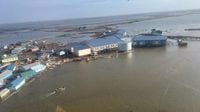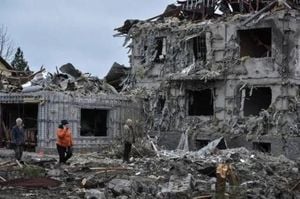When the remnants of Typhoon Halong barreled into western Alaska’s Yukon-Kuskokwim Delta on October 12, 2025, the catastrophe unfolded in ways that no weather model could fully anticipate. Satellite images and meteorological data showed color bands sweeping across maps, but for the people on the ground, the story was written in surging rivers, shifting homes, and the rising panic shared in real time on social media. TikTok, Facebook, and platforms like SIKU became lifelines, with residents posting videos of flooded roads, homes set afloat, and winds far stronger than forecasts had warned.
According to The Conversation and The Invading Sea, Halong’s storm surge flooded villages as far as 60 miles up the river. The water was so powerful that it pushed homes off their foundations, and in some heartbreaking cases, people found themselves afloat inside their own houses. More than 50 people had to be rescued in Kipnuk and Kwigillingok, and at least one death was reported. Hundreds were displaced, forced to grapple with the daunting question: Where do you go when your home is underwater and winter is closing in fast?
Halong was no ordinary storm. As Alaska climate specialist Rick Thoman of the University of Alaska Fairbanks explained to The Conversation, this ex-typhoon was fueled by near-record warm Pacific ocean temperatures. Just a week before striking Alaska, Halong was a powerful typhoon east of Japan. The jet stream swept it northeast, which is not uncommon, but as it neared Alaska, the storm took an unusual and unpredictable track—moving between Saint Lawrence Island and the Yukon-Kuskokwim Delta coast. Weather models did a decent job forecasting its general path, but as the storm drew closer, the forecasts changed rapidly. Within just 36 hours of landfall, the storm’s track and intensity shifted, leaving little time for communities to prepare or evacuate.
And here’s where the story gets even more complicated. In 2025, the Trump administration’s Department of Government Efficiency (DOGE) forced out hundreds of National Weather Service (NWS) employees, including critical positions in Alaska. According to The Invading Sea, this wave of firings, buyouts, and retirements cut deep into the backbone of the nation’s forecasting system. Weather balloons—a core tool for gathering upper-air data—became a casualty of these cuts. In Saint Paul Island, for example, no weather balloon observations had been made since late August. Kotzebue had lost its balloons since February, and Bethel and Cold Bay were reduced to just one launch per day instead of two. Nome, another crucial site, had no weather balloons for two days as Halong approached.
Weather balloons might sound old-fashioned, but they’re essential. They feed the models that guide nearly every forecast, providing vital information about atmospheric conditions. Fewer launches mean fewer data points, and that can cloud the clarity of forecasts—especially in a region as vast and unpredictable as Alaska. "Did any of this cause the forecast to be off? We don’t know because we don’t have the data, but it seems likely that that had some effect on the model performance," Thoman noted in The Conversation.
The consequences of these data gaps were felt acutely on the ground. Alaska’s delta region is uniquely vulnerable: the land is flat and low-lying, with some areas less than 10 feet above high tide. Permafrost is thawing, the land itself is subsiding, and sea levels are rising—a perfect storm for disaster when a major weather event hits. The ocean can surge far inland, and for many, there’s simply nowhere to go. Even Bethel, the region’s largest town, located 60 miles up the Kuskokwim River, suffered flooding from Halong.
Recovery in these remote communities is a logistical nightmare. There are no roads to cities, no big-box hardware stores, and certainly no extra housing stock. Supplies have to be barged in—everything from plywood to nails to windows—and that’s simply not possible once winter sets in. Planes can only carry small loads, and runways are short. The National Guard might be able to help, but even then, finding skilled labor to rebuild is another hurdle. "Everything is 100 times more complicated when it comes to building in remote communities," Thoman said. The region was already recovering from major flooding in summer 2024, with federal disaster aid for Kipnuk only approved in early January 2025—months after the waters receded.
For displaced families, the choices are grim. Do they leave for the winter, hoping to return and rebuild next summer? With housing so scarce and cities like Anchorage expensive, there is no easy answer. The trauma is compounded by the knowledge that recovery will be slow, piecemeal, and, for many, out of reach until the ice thaws and barges can once again ply the rivers.
Climate change is a shadow looming over every aspect of this disaster. Scientists can’t yet draw a direct line between warming and every single storm, but the evidence is mounting. The Pacific’s surface temperatures were unusually warm this fall, providing extra fuel for Halong. The storm also dragged warm air northward: Unalaska, east of the storm’s track, hit an all-time October high of 68 degrees Fahrenheit (20°C) on October 11, 2025. As Thoman noted, "Warm water fuels storms." With permafrost thawing and sea levels rising, the risks are only likely to grow.
Yet in the midst of destruction, Alaska is witnessing a shift in how weather information is shared and trusted. As one former National Weather Service social scientist wrote in The Invading Sea, "The models gave us the numbers; the stories gave us the context." During both Typhoon Merbok in 2022 and Halong in 2025, residents turned to social media to share live updates—sometimes providing crucial situational awareness faster than official channels. These real-time observations are already timestamped and geolocated, offering a wealth of place-based data.
There is growing potential to harness these community feeds—not as rumor mills, but as a vital layer of situational awareness for forecasters. In the past, Alaska’s Weather Service built community VHF radio channels, allowing residents to offer real-time corrections to forecasts. Today, TikTok, Facebook, and SIKU are the new VHF, brimming with visual, lived information. If forecasting desks could monitor verified community feeds during major events, forecasts might become not just more accurate, but more responsive to the lived reality of those in harm’s way.
This approach could also help rebuild trust in official forecasts, which has been battered by years of budget cuts and agency turnover. When people see their own perspectives reflected in official information, they’re more likely to believe the system is working for them, not just about them. "The future of forecasting in Alaska will not come only from satellites and supercomputers. It will come from people, the ones standing outside during the storm, holding up a phone, showing the rest of us what is really happening," the social scientist wrote.
As Alaska faces an uncertain future—where storms like Halong may become more frequent and severe—the path forward will depend not just on technology and funding, but on rebuilding the connections between forecasters and the communities they serve. In the end, the best forecasting tool might just be trust, rebuilt one shared story at a time.




